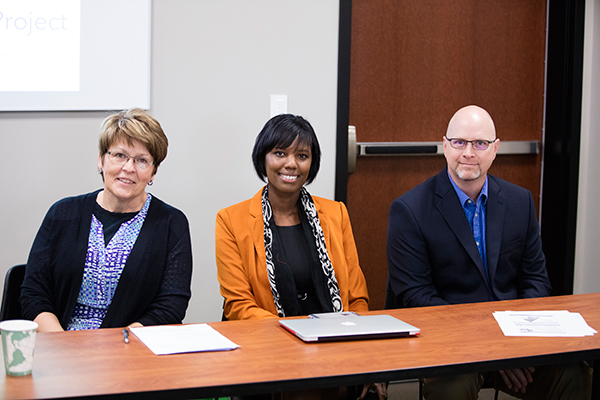Outstanding Nebraska Broadband Projects Recognized

Bonnie Carrell (representing the Rural Nebraska Health Care Network Broadband Fiber Network), Shonna Dorsey (representing Interface: The Web School), and Bradley Barker (representing Nebraska 4-H Robotics FIRST Lego League) were recognized at the Rural Futures Institute pre-conference on Oct. 21, 2015.
The Rural Nebraska Healthcare Network Broadband Fiber Network, Interface: The Web School, and Nebraska 4-H Robotics FIRST Lego League (FFL) were recognized as outstanding broadband projects by the Nebraska Broadband Initiative.
The Rural Nebraska Healthcare Network Broadband Fiber Network. The Rural Nebraska Healthcare Network (RNHN), a non-profit healthcare network with nine member hospitals in the Nebraska Panhandle, built a broadband fiber network in 2012 with funding from the Federal Communications Commission’s Rural Health Care Pilot Program. The 36-fiber redundant ring network in western Nebraska connects 10 hospitals, with leased circuits connecting an additional 13 hospitals in central/eastern Nebraska. The network has long-haul circuits to Omaha and Denver. The network is connected to the Nebraska Statewide Telehealth Network and has direct access to radiologists, laboratories, clinical pharmacists, and other specialists nationwide. Participating facilities transmit medical records, data, patient files, radiology, billing and other important patient and business-related information.
RNHN initially partnered with Mobius Communications in Hemingford. Mobius Communications brought the FCC funding opportunity to RNHN’s attention and assisted with the application process. Construction of the RNHN fiber network was made possible through a unique partnership with Zayo, a broadband provider. RNHN installed 84 fibers and leased 48 of them on a long-term basis to Zayo. The money that RNHN received from Zayo for the lease was sufficient to cover the RNHN’s portion of network construction costs. The Zayo 48-fiber commercial component has been developed by several Panhandle communication providers.
The 2 Gigabits per second redundant backbone allows images to be sent in real-time and the transfer of files in seconds or minutes, allowing easier access to patient records and information and supporting greater use of telemedicine and telehealth. The backbone capacity, which can be expanded as needed, is allowing member hospitals to provide off-site backup and disaster recovery services to each other.
RNHN members include Box Butte General Hospital, Chadron Community Hospital, Gordon Memorial Hospital, Kimball Health Services, Morrill County Community Hospital, Perkins County Health Services, Regional West Garden County, Regional West Health Services, and Sidney Regional Medical Center.
Interface: The Web School works to provide opportunities to learn code to everyone who wants to learn to do so. According to the Nebraska Department of Labor, there are currently over 4,000 unfilled tech jobs in the state of Nebraska alone. Interface: The Web School is addressing the need for a skilled IT workforce by providing introductory web development workshops to youth and adults as well as intensive web development training for those looking to enhance their skills and/or change careers.
Over 50 youth ages 6 to 12 have participated in web development workshops through Interface. The partnership with AIM, FUSE Coworking, and Omaha Public Library provided an opportunity to reach young girls, currently underrepresented in tech, to web development, one area of the tech field. Additionally, by offering these workshops at no/low cost to families and providing laptops for those who needed them, girls from all over the community were able to take advantage of this opportunity. One youth participant started a business inspired by the site she created.
Additionally over 100 adults have participated in Interface’s web development workshops. Following these sessions, adult participants report feeling more confident about working with code and find that some of what they learn in the free sessions can be immediately applied to their day-to-day tasks such as sending e-mail newsletters.
Over 100 adults have participated in Interface’s 11- to 15- week intensive web developer training courses. Students have gone from positions such as social worker and barista to technology specialist and junior web developer. In partnership with First National Bank, Interface ran a 10-week web developer training course during the fall of 2014 where four non-technical First National employees and eight external applicants were selected to participate in training with all tuition paid and full-time pay during the course. Through this program, First National transitioned the four employees into technical roles and hired one of the external candidates, who had been a full-time stay-at-home mom for 12 years prior to the course, as a developer at $55,000 per year. Another one of the external candidates was a barista before joining the course. Following the 10-week course, she landed a position with an agricultural technology company and is now a junior web developer. She has more than doubled her income in under one year and has moved her family out of her parents’ home.
Nebraska 4-H Robotics FIRST Lego League (FLL). To meet the need for more engineers and other STEM (Science, Technology, Engineering, and Mathematics) leaders, Nebraska 4-H Extension and our community partners have provided youth the opportunity to compete in the FIRST LEGO League (FLL) educational robotics competition program across Nebraska.
In 2015 Nebraska 4-H Extension hosted competitions for more than 100 FLL teams (about 714 youth) in six qualifying events in communities across the state (Omaha, Bellevue, Sidney, Kearney, Nebraska City, and South Sioux City) and one 48-team state championship hosted at the Nebraska Air and Space Museum in Ashland, Nebraska. Youth that participate in these robotics competitions build and program robots to accomplish specific tasks, communicate their engineering design processes, and complete a related research project.
Through their participation in the FLL competition, youth display increased interest in and understanding of science and technology, and the engineering design process. Through FLL participants are exposed to a wide array of different career professions. Nearly every team meets with STEM-career professionals and researches various STEM careers as part of FLL.
FLL program develops participants as leaders who support innovation. The program promotes innovation through the Core Value “What we discover is more important than what we win,” and by evaluating innovative project solutions and robot designs. Youth in FLL believe leadership is important, report high levels of leadership capacity, and perceive improvement in leadership capacity as a result of participating. With their high levels of engagement and interest in STEM, educational robotics program participants are in the STEM pipeline and are likely to build their self-efficacy in STEM, work harder as they expect achievement, and experience additional success as they continue in STEM.
The Nebraska Broadband Initiative (broadband.nebraska.gov) promotes the adoption and utilization of broadband in Nebraska. Project partners include the Nebraska Public Service Commission, University of Nebraska-Lincoln, Nebraska Information Technology Commission, Nebraska Department of Economic Development, and AIM.
